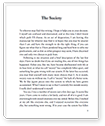Essay Instructions: Introduction:
Elderly patients have many needs that younger patients do not. Being discharged from the hospital after surgery can present additional issues beyond those associated with physical recovery. In this task, you will assume the role of a case management nurse who is responsible for determining the most appropriate discharge placement for an elderly patient named Mr. Trosack. The patient is to be discharged from the hospital after undergoing total hip replacement surgery.
Review the ?Elder Care Case Study? (attached below) for information on your patient. You will use this information to complete this task.
Task:
Write an essay (suggested length of 4 pages) in which you analyze the case study information to complete the following:
A. Assessment of the Situation (suggested length of 2 pages)
1. Identify at least three healthcare issues that you, as the case manager, must address when working with an interdisciplinary team to determine the most appropriate discharge plan for Mr. Trosack.
a. Explain why these are important issues when planning for management of the elderly discharge patient.
2. Identify three to five members to make up an interdisciplinary team to determine the most appropriate discharge placement for Mr. Trosack.
a. Describe the role expected of each person on the team.
3. Analyze the issues from the safety assessment that could affect the determination of discharge placement.
Note: You may include any other safety issues you think might be a problem if this patient returns home upon discharge.
B. Discharge Plan of Care (suggested length of 2 pages)
1. Explain to the family what care Mr. Trosack needs and how he should be discharged based on the interview data and the safety assessment. Your explanation should include the following:
a. Discuss the ability of the family to adequately care for Mr. Trosack if he is discharged home.
b. Discuss how social isolation affects an older adult?s recovery from surgery or illness.
c. Discuss the ways psychological factors play a role in the recovery process.
2. Recommend a discharge placement for Mr. Trosack with supportive documentation.
C. If you use sources, include all in-text citations and references in APA format.
Note: When using sources to support ideas and elements in a paper or project, the submission MUST include APA formatted in-text citations with a corresponding reference list for any direct quotes or paraphrasing. It is not necessary to list sources that were consulted if they have not been quoted or paraphrased in the text of the paper or project.
Note: No more than a combined total of 30% of a submission can be directly quoted or closely paraphrased from sources, even if cited correctly.
724.2.4-01-07 Case Study
You have just accepted the assignment of Mr. Trosack?s case management. As such, you are responsible for determining the most appropriate discharge placement and plan. From the patient?s chart, you are able to ascertain the following information:
PATIENT CHART:
Mr. Henry Trosack is a 72-year-old, second-generation Polish American who, until recently, has been in excellent health for all of his life. He reticently admits that prior to this hospitalization he has not had a physical examination in over 10 years, is taking no prescription medications, and has never had surgery in his life. In passing, he mentions taking some ?vitamins? to ?help his energy? every day, but he is not sure what they are. He wears glasses for reading and has hearing loss at 60% in his left ear.
Mr. Trosack manages a family-owned bakery along with his brother Karl, who is a widower. Mr. Trosack?s wife of 40 years, Helena, died two years ago at the age of 70. Mr. Trosack has lived in a two-bedroom apartment on the second floor in a three-story, post?WWII apartment building in downtown Chicago since he married his wife, Helena.
Mr. Trosack has one married son, Peter, 44, a financial consultant. Peter and his 43-year-old wife, Rita, both work an average of 60 hours a week and are trying to conceive their first child. They live in a condominium in downtown Chicago close to the lake and not far from the bakery. Although both were raised Catholic, neither chooses to practice their religion at this time. This infuriates Henry, but he doesn?t talk about it. Contact between Peter and his father is infrequent.
One month ago while taking out the trash, Mr. Trosack fell down the long flight of steps leading to the ground floor of his apartment building, fracturing his right hip. His brother called 911, and Henry was brought to the hospital where he underwent a right total hip replacement (THR) within 24 hours of admission. After a successful and uneventful surgery, Mr. Trosack has been in in-hospital rehabilitation for the past 2 weeks.
While in the hospital for the THR, it was determined that Mr. Trosack had hypertension. Mr. Trosack was prescribed Lopressor 25 mg bid for an average B/P of 160/100. He was also diagnosed with noninsulin-dependent diabetes for which he was prescribed Glucophage 500 mg twice a day to control his condition. After diabetic teaching in the hospital, he was able to perform his own blood sugar checks and was issued a glucometer for home use. Being overweight at 5?7?and 210 lbs., Mr. Trosack was also given dietary counseling to help him lose weight and to control his blood sugar. He was prescribed Percocet for any residual postoperative pain that might surface.
Upon discharge, Mr. Trosack will use a walker as the only means of assisted mobility. To determine the appropriate plan of care, you meet with the patient and then the family to gain more information. With the patient and family?s permission, you conduct a safety assessment of the patient?s apartment.
PATIENT INTERVIEW RESULTS:
Mr. Trosack is not happy about being what he calls ?disabled? and having to take the ?darn? medications. His apartment is on the second floor, and he is concerned that it will be difficult and painful to climb the stairs. While this frustrates him, he is determined to be able to help in the bakery. However, he admits that he cannot go down to the basement where the supplies are stored. Mr. Trosack insists that he can take care of himself and can take his own medications. He has lived alone for two years since his wife died.
FAMILY INTERVIEW RESULTS:
The family insists that according to earlier family discussions Mr. Trosack was supposed to return home with daily assistance from family members who would take turns running the store while seeing to his needs. When asked, the son and his wife admitted that they work a minimum of sixty-hour weeks and have had little time in the past to visit Mr Trosack. They hope to do better once he is home, but they know that right now there is a lot of pressure from work.
When questioned, the family did not appear to understand the need for taking medications at regular times. They do not believe that he really has diabetes since he has always been so healthy. They believe a change of diet will probably be all that is needed.
The family states that they do not know how Mr. Trosack obtains his groceries, but they are sure there is a store nearby that will deliver. Mr. Trosack usually eats his meals in the bakery so he does not keep much food in the apartment.
The family also believes that Mr. Trosack will follow directions and remain in the apartment rather than going downstairs to the bakery. The family refuses any outside nursing assistance since they know that Mr. Trosack will not want anyone ?fussing? over him. However, they will try to visit as often as possible.
The family states that Mr. Trosack?s apartment is small and cluttered with WWII memorabilia. They admit that it may be difficult to maneuver the walker around furniture and his ?valuables.? However, they state that, ?Maybe this will finally get him to get rid of all that junk.? The family states that Mr. Trosack is alert and well able to care for himself. He has been living alone without difficulty for two years since his wife died.
SAFETY ASSESSMENT:
??Apartment is small and cluttered with furniture and memorabilia.
??Bathroom is small and does not include any safety features.
??Kitchen is small but clean, and there is room to maneuver with the walker.
??Controls for the stove are in the front making it easy to reach.
??Access to the apartment is by two flights of stairs.
??There is no elevator.
??Trash must be taken down the two flights of stairs to the rear of the building.
??Groceries must be brought up the two flights of stairs.
??Bathroom medicine cabinet is filled with old prescriptions.
??Food in the refrigerator is expired.
??Multiple, small scatter rugs are present throughout the apartment, even on top of other carpets.


